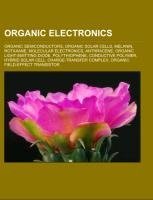
Organic electronics
Source: Wikipedia. Pages: 71. Chapters: Organic semiconductors, Organic solar cells, Melanin, Rotaxane, Molecular electronics, Anthracene, Organic light-emitting diode, Polythiophene, Conductive polymer, Hybrid solar cell, Charge-transfer complex, Organic... Viac o knihe
Produkt je dočasne nedostupný
18.66 €
bežná cena: 21.20 €
O knihe
Source: Wikipedia. Pages: 71. Chapters: Organic semiconductors, Organic solar cells, Melanin, Rotaxane, Molecular electronics, Anthracene, Organic light-emitting diode, Polythiophene, Conductive polymer, Hybrid solar cell, Charge-transfer complex, Organic field-effect transistor, Polyaniline, Pentacene, Negative resistance, Polymer solar cell, John McGinness, Konarka Technologies, Active-matrix OLED, Flexible organic light-emitting diode, Poly(p-phenylene vinylene), Tetrathiafulvalene, Catenane, Plextronics, Solarmer Energy, Inc., PEDOT-TMA, Polyacetylene, Diindenoperylene, Alan J. Heeger, Poly(p-phenylene sulfide), Poly(3,4-ethylenedioxythiophene), Polypyrrole, Rubrene, Hexacene, Quinacridone, PEDOT:PSS, 9,10-Bis(phenylethynyl)anthracene, Poly(p-phenylene oxide), Tetracene, Capillary action through synthetic mesh, Conductive Characteristics within Coated Synthetic Fabrics, 9,10-Diphenylanthracene, Super AMOLED, 1-Chloro-9,10-bis(phenylethynyl)anthracene, 2-Chloro-9,10-bis(phenylethynyl)anthracene, 5,12-Bis(phenylethynyl)naphthacene, Printable Electronics Technology Centre, Organic Light Emitting Transistor, Perfluoropentacene. Excerpt: An organic light emitting diode (OLED) is a light-emitting diode (LED) in which the emissive electroluminescent layer is a film of organic compounds which emit light in response to an electric current. This layer of organic semiconductor material is situated between two electrodes. Generally, at least one of these electrodes is transparent. OLEDs are used in television screens, computer monitors, small, portable system screens such as mobile phones and PDAs,watches, advertising, information, and indication. OLEDs are also used in light sources for space illumination and in large-area light-emitting elements. Due to their early stage of development, they typically emit less light per unit area than inorganic solid-state based LED point-light sources. An OLED display functions without a backlight. Thus, it can display deep black levels and can be thinner and lighter than liquid crystal displays. In low ambient light conditions such as dark rooms, an OLED screen can achieve a higher contrast ratio than an LCD using either cold cathode fluorescent lamps or the more recently developed LED backlight. There are two main families of OLEDs: those based upon small molecules and those employing polymers. Adding mobile ions to an OLED creates a Light-emitting Electrochemical Cell or LEC, which has a slightly different mode of operation. OLED displays can use either passive-matrix (PMOLED) or active-matrix addressing schemes. Active-matrix OLEDs (AMOLED) require a thin-film transistor backplane to switch each individual pixel on or off, and can make higher resolution and larger size displays possible. The first observations of electroluminescence in organic materials were in the early 1950s by A. Bernanose and co-workers at the Nancy-Université, France. They applied high-voltage alternating current (AC) fields in air to materials such as acridine orange, either deposited on or dissolved in cellulose or cellophane thin films. The proposed mechanism was either direct excitation of
- Vydavateľstvo: Books LLC, Reference Series
- Formát: Paperback
- Jazyk:
- ISBN: 9781156688694




 Anglický jazyk
Anglický jazyk 







